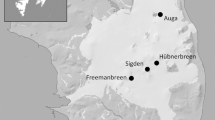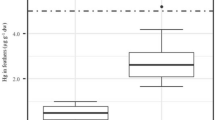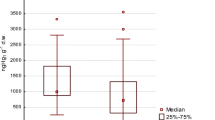Abstract
The ivory gull is a high-Arctic species considered endangered in most parts of its breeding range. Ivory gulls must cope with both the reduction of sea ice cover triggered by climate change and increasing contaminant loads due to changes in global contaminant pathways. The objective of this study was to assess the concentration of 14 essential and nonessential trace elements at four colonies of ivory gulls breeding on Barentsøya, Svalbard, and the relationship between contaminant exposure and the diet of individuals. Contaminants and stable isotopes (δ15N, δ13C) were determined in blood (red blood cells and whole blood), and feathers of ivory gulls collected over several years. The most quantitatively abundant nonessential trace element found in the ivory gull was mercury (Hg). Selenium (Se) was present in substantial surplus compared with Hg, which would imply relative protection against Hg toxic effects but raises concern about Se potential toxicity. Moreover, other elements were detected, such as silver, arsenic, cadmium, and lead, which would warrant monitoring because of the potential additive/synergetic effects of these compounds. This study demonstrated individual differences in trophic behaviour that triggered discrepancies in Hg concentrations, highlighting the potential biomagnifying ability of this metal in the ivory gull’s food web. Results highlighted the mixing of birds coming from different geographical areas on Barentsøya.




Similar content being viewed by others
References
Anderson MJ, Gorley RN, Clarke KR (2008) PERMANOVA+ for PRIMER: guide to software and statistical methods. PRIMER-E Ltd, Plymouth
Anderson ORJ, Phillips RA, Shore RF, McGill RAR, McDonald RA, Bearhop S (2010) Element patterns in albatrosses and petrels: influence of trophic position, foraging range, and prey type. Environ Pollut 158:98–107
Arctic Monitoring and Assessment Programme (1997) Arctic pollution issues: a state of the Arctic Environment report. AMAP, Oslo
Arctic Monitoring and Assessment Programme (2011) AMAP assessment 2011: Mercury in the Arctic. AMAP, Oslo
Barceloux DG (1999) Selenium. Clin Toxicol 37:145–172
Bond AL, Hobson KA, Branfireun BA (2015) Rapidly increasing methyl mercury in endangered ivory gull (Pagophila eburnea) feathers over a 130 year record. Proc R Soc B 282:20150032
Braune BM, Scheuhammer AM (2008) Trace element and metallothionein concentrations in seabirds from the Canadian Arctic. Environ Toxicol Chem 27:645–651
Braune BM, Mallory ML, Gilchrist HG (2006) Elevated mercury levels in a declining population of ivory gulls in the Canadian Arctic. Mar Pollut Bull 52:969–987
Braune BM, Mallory ML, Gilchrist HG, Letcher RJ, Drouillard KG (2007) Levels and trends of organochlorines and brominated flame retardants in Ivory Gull eggs from the Canadian Arctic, 1976 to 2004. Sci Total Environ 378:403–417
Burger J, Gochfeld M (1997a) Risk, mercury levels, and birds: relating adverse laboratory effects to field biomonitoring. Environ Res 75:160–172
Burger J, Gochfeld M (1997b) Age differences in metals in the blood of herring (Larus argentatus) and Franklin’s (Larus pipixcan) gulls. Arch Environ Contam Toxicol 33:436–440
Burgess NM, Meyer MW (2008) Methylmercury exposure associated with reduced productivity in common loons. Ecotoxicology 17:83–91
Campbell LM, Norstrom RJ, Hobson KA, Muir DCG, Backus S, Fisk AT (2005) Mercury and other trace elements in a pelagic Arctic marine food web (Northwater Polynya, Baffin Bay). Sci Total Environ 351–352:247–263
Clarke KR, Gorley RN (2006) PRIMER v6: user manual/tutorial. PRIMER-E Ltd, Plymouth
Divoky GJ (1976) The pelagic feeding habits of ivory and Ross’ gulls. Condor 78:85–90
Eisler R (1988) Arsenic hazards to fish, wildlife, and invertebrates: a synoptic review. Contaminant hazard reviews report No. 12, U.S. Department of the Interior, Fish and Wildlife Service, biological report 85(1.12)
Eisler RA (1994) A review of arsenic hazards to plants and animals with emphasis on fishery and wildlife resources. In: Nriagu JO (ed) Arsenic in the environment, part II: human health and ecosystem effects. Wiley, New York, pp 185–259
Gibson LA, Lavoie RA, Bissegger S, Campbell LM, Langlois VS (2014) A positive correlation between mercury and oxidative stress-related gene expression (GPX3 and GSTM3) is measured in female Double-crested Cormorant blood. Ecotoxicology 23:1004–1014
Gilchrist HG, Mallory ML (2005) Declines in abundance and distribution of the ivory gull (Pagophila eburnea) in Arctic Canada. Biol Cons 121:303–309
Gilg O, Strøm H, Aebischer A, Gavrilo MV, Volkov AE, Miljeteig C, Sabard B (2010) Post-breeding movements of Northeast Atlantic ivory gull Pagophila eburnea populations. J Avian Biol 41:532–542
Goutte A, Barbraud C, Meillère A, Carravieri A, Bustamante P, Labadie P, Budzinski H, Delord K, Cherel Y, Weimeskirch H, Chastel O (2014a) Demographic consequences of heavy metals and persistent organic pollutants in a vulnerable long-lived bird, the wandering albatross. Proc R Soc B 281:20133313
Goutte A, Bustamante P, Barbraud C, Delord K, Weimeskirch H, Chastel O (2014b) Demographic responses to mercury exposure in two closely-related Antarctic top predators. Ecology 95:1075–1086
Hobson KA, Bond AL (2012) Extending an indicator: year-round information on seabird trophic ecology from multiple-tissue stable-isotope analyses. Mar Ecol Prog Ser 461:233–243
Hobson KA, Fisk A, Karnovsky N, Holst M, Gagnon JM, Fortier M (2002) A stable isotope (δ13C, δ15N) model for the North Water food web: implications for evaluating trophodynamics and the flow of energy and contaminants. Deep-Sea Res II 49:5131–5150
Hoffman DJ (2002) Role of selenium toxicity and oxidative stress in aquatic birds. Aquat Toxicol 57:11–26
Howell SNG (2001) Molt of the ivory gull. Waterbirds 24:438–442
Ikemoto T, Kunito T, Tanaka H, Baba N, Miyazaki N, Tanabe S (2004) Detoxification mechanism of heavy metals in marine mammals and seabirds: interaction of selenium with mercury, silver, copper, zinc, and cadmium in liver. Arch Environ Contam Toxicol 47:402–413
Jardine TD, Kidd KA, Fisk AT (2006) Applications, considerations, and sources of uncertainty when using stable isotope analysis in ecotoxicology. Environ Sci Technol 40:7501–7511
Karnovsky NJ, Hobson KA, Brown ZW, Hunt GL Jr (2009) Distribution and diet of ivory gulls (Pagophila eburnea) in the North Water Polynya. Arctic 62:65–74
Khan MAK, Wang F (2009) Mercury-selenium compounds and their toxicological significance: towards a molecular understanding of the mercury-selenium antagonism. Environ Toxicol Chem 28:1567–1577
Kunito T, Kubota R, Fujihara J, Agusa T, Tanabe S (2008) Arsenic in marine mammals, seabirds, and sea turtles. Rev Environ Contam Toxicol 195:31–69
Lemly A (1999) Selenium transport and bioaccumulation in aquatic systems: a proposal for water quality criteria based on hydrological units. Ecotoxicol Environ Saf 42:150–156
Lucia M, Bocher P, Chambosse M, Delaporte P, Bustamante P (2013) Trace element accumulation in relation to trophic niches of shorebirds using intertidal mudflats. J Sea Res 92:134–143
Lucia M, Verboven N, Strøm H, Miljeteig C, Gavrilo MV, Braune BM, Boertmann D, Gabrielsen GW (2015) Circumpolar contamination in eggs of the high-Arctic ivory gull Pagophila eburnea. Environ Toxicol Chem 34:1552–1561
Lucia M, Strøm H, Bustamante P, Herzke D, Gabrielsen GW (2016) Contamination of ivory gulls (Pagophila eburnea) at four colonies in Svalbard in relation to their trophic behavior. Polar Biol. doi:10.1007/s00300-016-2018-7
Macdonald RW, Barrie LA, Bidleman TF, Diamond ML, Gregor DJ, Semkin RG, Strachan WMJ, Li YF, Wania F, Alaee M, Alexeeva LB, Backus SM, Bailey R, Bewers JM, Gobeil C, Halsall CJ, Harner T, Hoff JT, Jantunen LMM, Lockhart WL, Mackay D, Muir DCG, Pudykiewicz J, Reimer KJ, Smith JN, Stern GA, Schroeder WH, Wagemann R, Yunker MB (2000) Contaminants in the Canadian Arctic: 5 years of progress in understanding sources, occurrence and pathways. Sci Total Environ 254:93–234
Macdonald RW, Harner T, Fyfe J (2005) Recent climate change in the Arctic and its impact on contaminant pathways and interpretation of temporal trend data. Sci Total Environ 342:5–86
Mallory ML, Braune BM, Provencher JF, Callaghan DB, Gilchrist HG, Edmonds ST, Allard K, O’Driscoll NJ (2015) Mercury concentrations in feathers of marine birds in Arctic Canada. Mar Poll Bull 98:308–313
Mehlum F (1990) Seabird distribution in the northern Barents Sea marginal ice-zone during late summer. Polar Res 8:61–65
Mehlum F, Gabrielsen GW (1993) The diet of High-Arctic seabirds in coastal and ice-covered, pelagic areas near the Svalbard archipelago. Polar Res 12:1–20
Miljeteig C, Strøm H, Gavrilo MV, Volkov A, Jenssen BM, Gabrielsen GW (2009) High levels of contaminants in ivory gull Pagophila eburnea eggs from the Russian and Norwegian Arctic. Environ Sci Technol 43:5521–5528
Muir D, Braune B, DeMarch B, Norstrom R, Wagemann R, Lockhart L, Hargrave B, Bright D, Addison R, Payne J, Reimer K (1999) Spatial and temporal trends and effects of contaminants in the Canadian Arctic marine ecosystem: a review. Sci Total Environ 230:83–144
Muscatello JR, Janz DM (2009) Selenium accumulation in aquatic biota downstream of a uranium mining and milling operation. Sci Total Environ 407:1318–1325
Øverjordet IB, Gabrielsen GW, Berg T, Ruus A, Evenset A, Borgå K, Christensen G, Lierhagen S, Jenssen BM (2015) Effect of diet, location and sampling year on bioaccumulation of mercury, selenium and cadmium in pelagic feeding seabirds in Svalbard. Chemosphere 122:14–22
Pacyna JM (1995) The origin of Arctic air pollutants: lessons learned and future research. Sci Total Environ 160–161:39–53
Poissant L, Zhang HH, Canario J, Constant P (2008) Critical review of mercury fates and contamination in the arctic tundra ecosystem. Sci Total Environ 400:173–211
Rubenstein DR, Hobson KA (2004) From birds to butterflies: animal movement patterns and stable isotopes. Trends Ecol Evol 19:256–263
Ruus A, Øverjordet IB, Braatem HFV, Evenset A, Christensen G, Heimstad ES, Gabrielsen GW, Borgå K (2015) Methylmercury biomagnification in an Arctic pelagic food web. Environ Toxicol Chem 34:2636–2643
Sele V, Sloth JJ, Julshamn K, Skov K, Amlund H (2015) A study of lipid- and water-soluble arsenic species in liver of Northeast Arctic cod (Gadus morhua) containing high levels of total arsenic. J Trace Elem Med Biol 30:171–179
Spencer NC, Gilchrist HG, Mallory ML (2014) Annual movement patterns of endangered ivory gulls: the importance of sea ice. PLoS One 9:e115231
Stewart MS, Spallholz JE, Neldner KH, Pence BC (1999) Selenium compounds have disparate abilities to impose oxidative stress and induce apoptosis. Free Radic Biol Med 26:42–48
Thompson DR, Furness RW (1989) Comparison of the levels of total and organic mercury in seabird feathers. Mar Pollut Bull 20:577–579
Acknowledgments
Funding was provided by Seventh Framework Programme (Grant no. 622019). The authors thank the European Commission for its financial support through a Marie Curie fellowship to M. Lucia, as well as Gael Guillou from the plateforme “Analyses Isotopiques” of LIENSs for technical support during isotopic analyses. We thank Carine Churlaud and Maud Brault-Favrou from the plateforme “Analyses Elémentaires” of LIENSs for their assistance with chemical analyses. The CPER (Contrat de Projet Etat-Région) is acknowledged for the funding of the ICP and AMA. The fieldwork was supported by the Norwegian Polar Institute’s centre for Ice, Climate and Ecosystems (ICE), and the SEAPOP program (seapop.no). Thanks to Vidar Bakken, Audun Igesund, Cecilie Miljeteig, Knut Olsen, Maria Gavrilo, Olivier Gilg, and Odd Kindberg for help in the field.
Author information
Authors and Affiliations
Corresponding author
Rights and permissions
About this article
Cite this article
Lucia, M., Strøm, H., Bustamante, P. et al. Trace Element Concentrations in Relation to the Trophic Behaviour of Endangered Ivory Gulls (Pagophila eburnea) During Their Stay at a Breeding Site in Svalbard. Arch Environ Contam Toxicol 71, 518–529 (2016). https://doi.org/10.1007/s00244-016-0320-6
Received:
Accepted:
Published:
Issue Date:
DOI: https://doi.org/10.1007/s00244-016-0320-6




